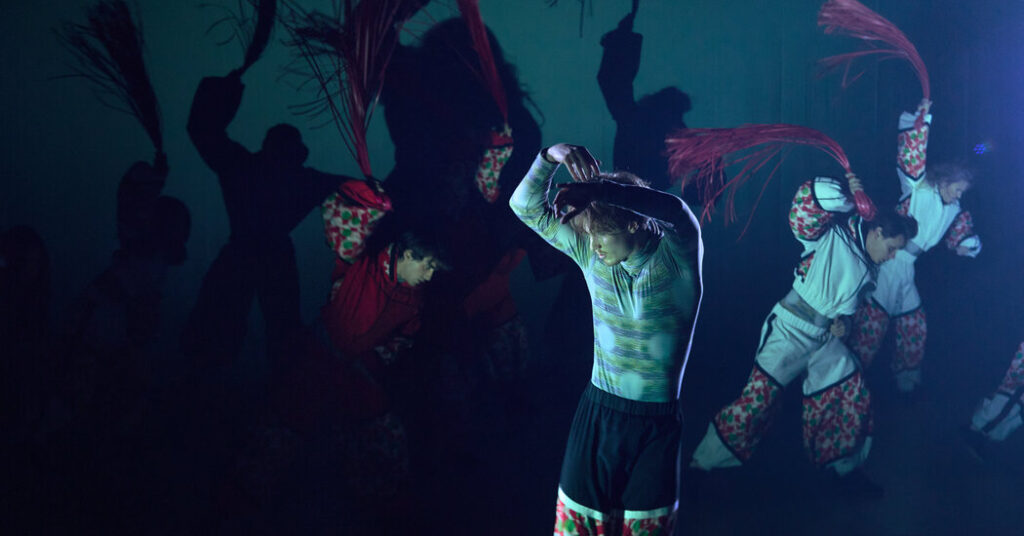Far in the north of Norway, a test of sorts was underway.
Two weeks earlier, the ballet “Lahppon/Lost” had premiered at the Opera House in Oslo. Created by a Sami artist about a Sami uprising, and danced by the Norwegian National Ballet, the work had opened to largely positive reviews. But last Friday, “Lahppon/Lost” started a two-night run in Kautokeino, a cultural capital for the Indigenous Sami people and the very town where the rebellion it depicts took place.
“The audience was five times bigger in Oslo, but I was more nervous here,” said the creator and co-choreographer of “Lahppon/Lost,” Elle Sofe Sara, whose ancestors participated in the uprising. “I knew that so many descendants of the rebellion would be there, and I kept feeling that I had taken their story. I was asking myself: ‘Have we done it in a good way?’”
She wasn’t the only one asking.
When the work premiered at the Opera House on Oct. 31, it was the first time a piece by a Sami choreographer had been presented on the main stage. It was also part of a recent wave of commissions from leading arts institutions that have recognized Norway’s long history of forced assimilation of and discrimination against the Indigenous group, which is widely considered Europe’s oldest, and whose lands stretch across the northern reaches of Norway, Sweden, Finland and Russia’s Kola Peninsula.
Yet for Ingrid Lorentzen, the Norwegian National Ballet’s artistic director, who commissioned the work, and for the company’s dancers, none of whom are Sami, the performance raised questions about whether they had the right to tell the story.
“It was my recurring nightmare,” said Lorentzen. “Are we again stepping over the voices that we are trying to create space for? Can it really be a collaboration and not us just pushing our way in and saying” — she thrust out her arms dramatically — “‘We’re here?’”
For the Sami, the Kautokeino rebellion remains a sensitive subject. During the 1852 uprising, Sami followers of a strict Christian sect attacked Norwegian authorities, including the local sheriff and priest. The rebels were arrested and — in the case of two leaders — beheaded. In the aftermath, church and state stepped up their efforts to “Norwegianize” the Indigenous group, which continued into the 1960s.
For well over a century, the rebellion was shrouded in shame among the Sami. But a political and cultural awakening in the 1970s prompted a gradual re-evaluation, and today the causes and meaning of the Kautokeino uprising are contested, with some viewing it as an example of religious fanaticism and others considering it an early Indigenous rejection of the authorities’ ongoing suppression of Sami rights and culture.
Among the predominantly Indigenous audience that filled the seats of Kautokeino’s Sami National Theater, several attendees confessed to pre-curtain anxiety over whether the work would treat the event with sufficient sensitivity.
“I was so nervous,” said Ayla Nutti, 20. “I was worried they wouldn’t get it right.”
It was precisely the uprising’s complexity that drew Sara to the story. From her research, she knew that the episode still carried a heavy emotional burden. “We did interviews with descendants, and some of them didn’t want to talk about it, or they would talk and then tell us to delete the conversation,” she said.
While she understood the potential implications of having non-Sami dancers perform her work, she also saw an artistic opportunity. “Dancers at this level can do something that Sami can’t,” Sara said. “They carry it with their body in a different way, and physicalize it.”
The dancing in “Lahppon/Lost” is intensely physical, and much of it was devised by Sara’s collaborator, the Icelandic choreographer Hlin Hjalmarsdottir. The dancers whip the ground with fury and twist their bodies with an energy that oscillates between tortured and ecstatic. Combined with video close-ups of the dancers’ faces, and striking costumes from the Danish designer Henrik Vibskov, the muscular movement gives “Lahppon/Lost” a contemporary feel.
Yet the work remains thoroughly Sami. Much of that character can be attributed to Lavre Johan Eira, who performs a Sami form of throat singing called joiking that is believed to convey the living essence of its subject. “Lahppon/Lost” opens with Eira’s haunting version of a joik representing Aslak Haetta, one of the beheaded men — a song that, according to local lore, was passed to a famous joiker via an anonymous phone call.
Eira also composed his own joiks for “Lahppon/Lost,” including one that closes the ballet and that came to him complete, he said, almost as if he were taking dictation. “It was only later that it became clear to me that it was the memory of rebellion from the perspective of Aslak Haetta’s younger brother,” Eira explained.
Sara held sessions on Sami history for the dancers, and over the summer, a small group of them spent two weeks in Kautokeino, learning about the local culture. The immersion continued on the morning of their second performance in town, when they were introduced to traditional reindeer herding practices like lassoing and sledding by Aslak Sokki, a Kautokeino herder who runs a camp that educates visitors in Sami heritage.As one buck sped off with Samantha Lynch, an Australian who is one of the company’s principal dancers, she clung to the sled and prayed that she wouldn’t crash. “All I could think was, ‘I’ve got to dance ‘The Nutcracker’ in two weeks!’” she said.
The dancers were acutely aware of the delicacy of their outsider status. ”The challenge was: How are we going to make the Sami believe their own story when we’re not from here?” said Anaïs Touret, a French ballerina whose sensual duet with Jim de Block is a highlight of “Lahppon/Lost.” “We had to really feel the story, to be able to transmit this feeling back to the audience,” she said.
By all accounts — and two standing ovations — they succeeded. “Sometimes when you see non-Sami dancers, there is a distance between them and the Sami stories,” said Kristin Solberg, the director of a Sami theater in Mo i Rana, Norway. “But these dancers embodied them and gave movement to the land. I felt like I was watching my story.”
Sokki, the reindeer herder, found himself in tears. “It didn’t matter that the dancers weren’t Sami,” he said. “They made the rebellion come closer. It was magic.”
In the intimate space of the Kautokeino theater, the performers felt that magic, too. And it didn’t end with the curtain. As they stepped outside after the final show, the Northern Lights were casting swirling bands of luminescence against the night sky. “It’s the perfect ending,” said de Block, the dancer. “We released the spirits tonight.”
The post An Indigenous Ballet Was a Hit in the City. But in the Sami Heartland? appeared first on New York Times.




